Many of you may know that my “day job” (which I actually do at night) is that I’m a martial arts instructor.
For this reason, often martial arts lingo and principles find their way into how and what I teach about trading options.
Today I’ll demonstrate an example of trading that’s in line with a classic of Chinese literature that great generals from many nations have read: The Art of War by Sun Tzu.
Oh, and make no mistake about it… trading IS war 😉
In Sun Tzu’s classic, one of the founding principles of how to make war effectively is to FIRST shore up one’s position so that it’s very difficult to attack. THEN, after making it hard for the enemy to do any real damage to your main force, you take small units and do little skirmishes here and there that have a high likelihood of success, while risking very little.
I know what you’re thinking… “Sounds great, Kurt, IF I were a general commanding a force in war…”
Oh, but you ARE. See, every dollar you have in your account is a soldier. And your strategy for winning in the long term has GOT to be centered around making it hard to penetrate the defenses. IN this post I will be sharing how to do just that… how to shore up the defenses around your “force”. But another, VERY important part is the minor skirmishes that have a high probability of success, and very little risk if you are wrong.
I think you’ll be excited to see a “skirmish” I completed just recently… a Bear Call Spread done with ZERO risk. That sounds a little weird, I know… but it’s true. In a certain context I can show you how to put together a bear call spread trade at a credit that wins if your stock stays flat or goes down… but if the stock goes up there are none of the consequences normally attached to a bear call spread.
Interesting? Yer darn tootin’ it is! First, let’s look at the “fortified position”. Sun Tzu would be proud. You can click the picture to see the details larger:
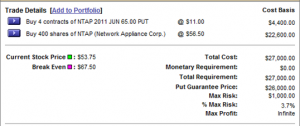
Married Put on CTSH
On January 7, 2011 NTAP was trading at $56.50 and the June 2011 $65 put options were at $11.00 even.
By purchasing them BOTH at the same time, one could guarantee maximum risk to their capital of only 3.7%. That’s not a “stop” order, which folks caught by the so-called ‘flash crash’ know adds no real measure of safety…
No, this put option is a legal and binding contract guaranteeing a minimum sales price of $65 for an asset whose total per-share price is $67.50. Total AT RISK is the difference of $2.50 per share, or $1,000 total if we have 400 shares protected by 4 put option contracts.
Take a look at the graphic representation of this kind of trade. While there is a “floor” for the possible losses, there is
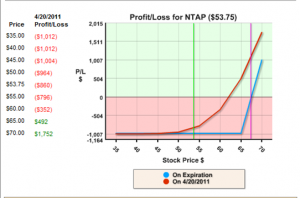
- Married Put on NTAP: Limited Risk, UNlimited Upside Potential
no ceiling!
The most exciting part of owning a married put is being able to sleep at night, knowing that no matter what happens to the underlying stock, the damage will be absolutely contained if it goes down. On the other hand, there is no limit to how high your profits may run in the case of good news or institutional sponsorship.
Can you imagine going in to an earnings announcement or other anticipated event that has the potential to send your stock EITHER way… and knowing that nothing really that bad can happen, but you CAN end up winning? If you haven’t experienced this peace of mind yet… it’s breathtaking. Upside: UN-limited. Total amount AT RISK: $1,000 even.
Okay, so that’s the Sun Tzu- friendly method I use for defense. I make it so that come what may, my fortifications are keeping my little soldiers safe from harm. But what about the minor skirmishes with a high chance of success? Take a look at the Bear Call Spread. Again, you may click to enlarge the picture:
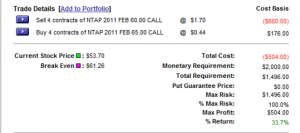
Bear Call Spread: More Risk Than Possible Reward
By selling the February $60 calls, while at the same time taking part of the premium received and using it to buy an equal amount of February $65 calls… a Bear Call Spread is formed.
In this case, I picked up $1.26 per spread, or times four, $504 total net credit.
That’s WONDERFUL… unless the stock goes up! I get to keep all the credit if the stock stays flat or goes down, but I have an obligation to make good if NTAP rises. For the privilege of taking that $504 credit, I may have to pay back as much as $2,000 if the stock trades at $65 or better. Total amount AT RISK: $1,496.
Here’s where the analogy to Sun Tzu’s Art of War comes in: what if we did BOTH of these trades? There are two distinct trades in place, with different objectives. One risks $1,000 and is long-term.
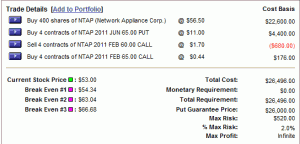
Nested Trades- One Within the Other
The other trade, the Bear Call Spread, risks $1,496 and is short-term. The total amount AT RISK if we add the risk from the $1,000 Married Put trade to the risk of $1,496 from the Bear Call Spread trade is…
$ 520??? Can that be RIGHT?
Yes. Because for the Bear Call Spread to go as bad as it possibly can against us, the stock has to go… UP. And we OWN the stock, remember? It’s usually a good thing if your stock goes up when you own it 😉
By doing this “nested” trade, which I call Income Method #6, we have effectively canceled almost half of the risk that was in the trade to begin with. If the stock stays down, we get to keep 100% of the premium generated by the Bear Call Spread… and guess what?
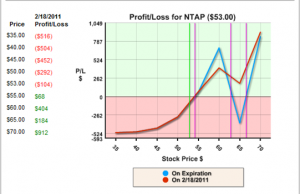
The 'HeartBeat': Adding a Bear Call Spread Breathes in LIFE
This is a February play, but the Married Put keeps us safe clear out to June. Can we do it again? Yessir, you betcha.
Repeated applications of this technique can lead to the coveted state that we refer to as “Bulletproof”: when the cost basis of your stock plus put is LOWER than the strike price of the put. Unlimited upside still, but NO way to lose.
SO there we go peeps… the merger of two great ideas from Sun Tzu’s Art of War. First, make yourself invincible. Then, attack the enemy with small detachments with a high likelihood of success and low consequences if they fail.
Last expiration Friday, this Bear Call Spread (Income Method #6) play expired totally worthless, so I was able to set the total credit against the cost basis of the stock in the Married Put play. Pretty cool? My new AT RISK amount is no longer 3.7%, but 1.9%. And there is still an unlimited upside in case the stock recovers by June.
Oh, and with TEN “Income Method” plays at my disposal… there are more ways to win between now and then. I’ll letcha know how it goes.
Happy Trading,
Kurt





 I'm Kurt Frankenberg, and I have discovered how to truly put the odds on the side on the individual investor.
I'm Kurt Frankenberg, and I have discovered how to truly put the odds on the side on the individual investor.
How do you get this kind of thing to “bulletproof”? I see the graph going up and down but that’s related to what the price might be at expiry. How can you say there is no risk in this trade when you can still lose?
Geaorge, SOMETIMES you can “Bulletproof” a trade with one adjustment or Income Method as I call it. IN the case of this NTAP setup, it will take repeated applications of this particular Income Method… or it may not even be possible to bulletproof NTAP because of what the stock is doing. Point is, I have positioned myself for unlimited rewards in case the stock DID happen to go up, but my losses are (right now) a MAXIMUM of 1.9%, regardless of what the stock does from here. I like the idea of unlimited potential, but I like it even more when if something goes horribly wrong I still have 98.1 cents on the dollar to work with in the next trade!
I am confused. You are talking about CTSH but all of the charts and examples are for NTAP What have I missed?
DER…! Thanks John. I have another trade in place right now that happens to be bulletproof, and that’s with CTSH. I feel silly because I was thinking about both of them while writing about one. I’ll go in and change where it says “CTSH” to “NTAP” because that trade is what this article documents. Thanks for the sharp eye!
John, I have now corrected the post. Thanks again for catching the error. I’ll be posting soon on the CTSH trade I was telling you about that is bulletproof: can win more than it’s currently at but CAN’T lose. That’s a great state to be in, especially around earnings! Talk soon,
Kurt
Kurt – This is VERY interesting but I have a question please. If NTAP had hit $65/share before or on February’s expiration date, would that have been like locking in a loss early on in the strategy though – depending on the value of the June 65 Put you are long?
-$5650 = Cost of 100 shares
-$1100 = Cost of June 65 Put
-$6750 = Total Cost of Married Put
+ $126 = February Bear Call Spread Income
-$6624 = Net
Then comes February 18th and if NTAP had been at $65/share for example:
+$6500 = Sale of 100 shares at $65/share
– $500 = Cost to buy back the February Bear Call Spread
– $624 = Net
$Unknown = Value of the June 65 Put – If it is less than $624 there would be a loss right?
I guess I am thinking that in trying to lower the risk even further there is the possibility of having to take the loss early on instead of letting the trade run its course more. Or am I totally off base – which is very possible…
Thank you and sorry this message is so long. – Bob C
Not long at all, Bob! Your post is very incisive, a good thing to be when discussing trading. You are right that the value of the put is the great unknown here. In my experience (which is confirmed by MATH by the way), the time value in a far-away put option actually INCREASES with a near term rise in the stock’s price.
Note that I said the TIME value rises… not the intrinsic value. But since the time value swells AT the money… and since in your example the stock goes right to $65… that put will be worth potentially more than it ever will be if the stock continues to rise and time continues to go forward. So odds are that the put will bring a good price to settle out this trade.
What the addition of Income Method #6: Selling A Bear Call Spread did was not to guarantee a winner… but to take a trade that could possibly lose 3.8% while having unlimited upside to a trade that could possibly lose 1.9% while having unlimited upside.
The actual losses were 1.2%… NINE times less than the loss of 10.8% that the stock took in the same timeframe.
Did I mention the possibility of unlimited upside 😉 ? That’s the point of this post… to BRAG about a loser that was always positioned to be a winner, if the stock simply ‘rose to the occasion’. Do enough of these, kiss enough frogs… and one runaway champ will lead your account to overall wins.
Happy Trading,
Kurt
Two points:
1) Text and notes read ‘CTSH’, but image captures show ‘NTAP’. Could be a source of confusion for some readers.
2) Your short call strike (60) is less than your long put strike (65). My understanding of The Blueprint is that this is NOT advisable configuration. Am I wrong or am I missing something?
Joe, the cardinal rule of “sell AT or ABOVE the put’s strike price” is somewhat relaxed with Income Method #6, the Bear Call Spread in conjunction with a Married Put trade. If you sell a call below the put’s strike price you make a serious gamble that the stock is staying flat or going down in the near future and if you are wrong, you now have TWO ways to lose: if the stock goes way down OR way up. The Bear Call Spread, however… done correctly… captures premium in the near term without capping the upside in case of a run up. It’s a better way to go in a case like this.
Joe brings up a good point.. Had the stock went up, would the short call at the 60 strike be manageable with Income Method #2?
When looking at the Profit/Loss chart for NTAP, it seems to me that the short call should have been at the 65 strike or higher, so that the upside potential of the married put trade would cancel out the risk associated with Income Method #6.
The stock went down over the last few days, so maybe you were able to buy back the short call to close that portion of the bear call spread?
Hi James! I have nicknamed Income Method #6, “Gimme My Money NOW!” because the rule on selling calls at the put’s strike or higher is somewhat relaxed. In the case of NTAP, it was a good thing that I did sell at a lower set of strikes because that resulted in a higher premium, which I did end up netting- and NEEDING- to offset the risk of NTAP so well. All told, I ended up losing on the NTAP trade, 1.2% versus the 10.8% that the stock went down.
On the other hand, if NTAP had gone up, the very worst it could possibly get is if NTAP waited until expiry, then shot to $65 and hovered there. That would mean NO workable premium in the $65 calls, and the maximum loss in the Bear Call Spread. Well… SO? If NTAP were at $65, I’d be a happy camper because I might then
1) abandon the trade for a small gain… sell the puts and let the stock get assigned
2) roll the $60 call
3) roll the whole Bear Call Spread… I could buy to close the Feb $60/$65 and open a later month $60/$65 at a credit, but still with max loss locked in
4) allow the stock to be assigned and then use Income Method #7, which you might check out in the appropriate chapter in The Blueprint
There are more management opportunities than this of course, but the point is that doing the Bear Call Spread reduced risk in the married put trade, rather than adding to it. If NTAP had gone up, it would have almost guaranteed some small edge. Check the graph and max risk in the examples again. Thanks for the question!
HT,
K
this trade doesn’t seem to work for me at least on income level look at 1000 shares over a year you have to buy two puts (one in June, and when that expires another 5-6 months out) assume both at a price of 11, that is $11000 plus another $11000 that is 22,000 total in put buying. Forget about the underlying stock price it has no value in the income generating equation as it is protected by the puts.
Now let’s look at the income from the bear credit spread, worst case: you get a net credit of 1.26 in Feb, Mar, April May and June that is 1260x 5 = 6300 or twice a year x 2 = 12,600 in income so you are paying twice as much in put buying to make half as much in credit bear spreads. The out of the money calls expire worthless. In order to make this work you have to put on four times as many option positions if you keep buying back the option you sold, the only one making money is your broker.
bullet proof ?? I don’t think so. The strategy is a long term loser. Do the math.
Okay, LibNutJob, let’s do the math:
You must KNOW that the market will not stay the same in most cases. Therefore, this stock likely will go up or down.
If she goes down, in this setup I lose very little. Case in point: NTAP lost 10.8%. My personal losses were 1.2%. I do THAT math, it tells me I did nine times better than anyone holding that same stock during that same time. And with 98.8% of my capital left over when I go into the next play, I can do a lot better than any of those guys.
On the other hand, say the stock had gone up. Even if the stock had gone up so much that the bear call spread went against me… well, that means that the stock went UP. At this point, I do one or more of a number of management techniques that allow me to keep the win, cancel the loss, and re-position for the next go-round. Keep in mind I never “have” to manage until I make enough money to counteract the smaller loss. I can’t lose without winning. Hmm. Should I start doing math yet? 😉
If the stock DOES travel sideways, then that would mean that I get to keep the premium from the bear call spread and can do it (sell another bear call spread) again… ending up in one of the above situations again, only BETTER because my cost basis for the stock has gone down.
When my c/b goes down enough, as it very often has… so that the net cost for both the stock and the put is LOWER than the strike price of the put… it is in fact BULLETPROOF. It can’t possibly lose, the stock still can go up, and I still have the possibility of taking premium by way of the bear call or a plethora of other ‘nested’ spread trades without introducing any risk.
LibNutJob, I have traded this way since 2002, and entered my trades as a matter of public record. I’ve done this enough times that I have proven… through the crash of 2008 and other bad times… that if you limit your downside risk enough when you are wrong, yet leave your upside unlimited in case you are right… you can win overall EVEN if you are wrong about a stock’s direction more often than you are right.
If you’re really a skeptic you might log on to one of my semiweekly webinars and watch how it really works. Often I’ll trade real-time so there can be no argument about my posted results. Watch me put a position on, watch me adjust it, and watch me close it. You’ll have to reconsider your statement, “This doesn’t work for me.” It works for people in over thirty countries, and if you can follow directions it can work for you too.
Happy Trading,
Kurt
[…] Double Dippin’… Taking Even More Premium Than Covered Calls Catching Premium Better Than Covered Calls: The “Money Net”, Part Deux This Simple Trick Made My Stock BULLETPROOF Coaching Client Steve S., Makin’ Star-BUCKS… What on Earth Is a Nested Spread Trade? Options Trading Wisdom From The Art of War […]